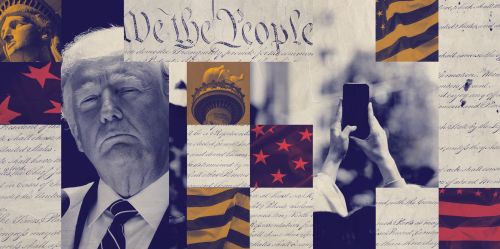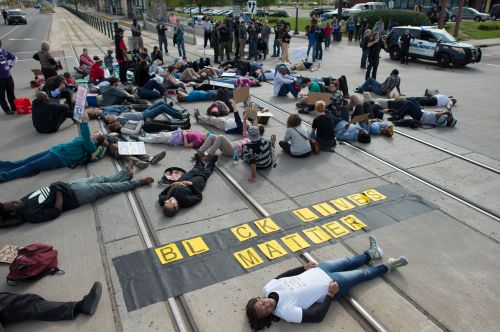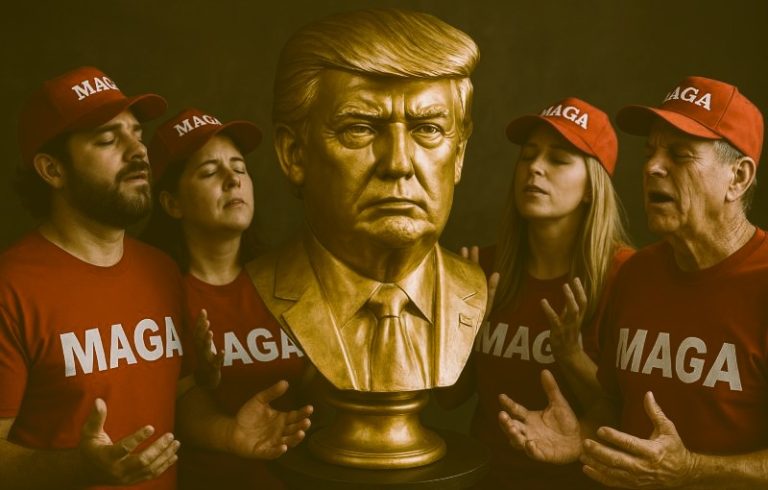

He is presiding over a system that maintains and even deepens surveillance practices.

By Matthew A. McIntosh
Public Historian
Brewminate
Introduction
The first presidency of Donald J. Trump, marked by political polarization, populist rhetoric, and contentious policy decisions, also saw a significant continuation—and in some cases expansion—of government surveillance of American citizens. Though the surveillance apparatus of the United States long predates Trump, his administration raised pressing questions about privacy, civil liberties, and executive power. Drawing from post-9/11 precedents, tech-enabled data collection, and political weaponization of intelligence, the first Trump years added complex layers to the debate over how the U.S. surveils its own population. That continues in his second term.
Inheriting the Surveillance State
When Donald Trump first took office in January 2017, he inherited a sprawling national security infrastructure built up under both George W. Bush and Barack Obama. The Patriot Act, passed swiftly after the September 11 attacks, gave U.S. intelligence agencies sweeping powers to collect data, conduct wiretaps, and surveil individuals within the United States suspected of links to terrorism.¹ These powers were later expanded under the Foreign Intelligence Surveillance Act (FISA) amendments and various executive orders.
While candidate Trump criticized aspects of this apparatus—especially when alleging that his own campaign had been “spied on” by the Obama administration²—President Trump ultimately presided over a system that maintained and even deepened surveillance practices.
Section 702 Reauthorization: A Moment of Contradiction

One of the most telling moments in Trump’s surveillance policy came in early 2018 with the reauthorization of Section 702 of the FISA Amendments Act, which allows the government to collect emails, phone calls, and other communications of foreigners abroad without a warrant. However, this surveillance often incidentally captures communications of Americans.³
Despite initially tweeting concerns that FISA was used to “spy” on his campaign, Trump signed the reauthorization into law in January 2018.⁴ Civil liberties organizations like the ACLU criticized the move, arguing that it allowed the FBI and NSA to continue accessing Americans’ communications without a warrant.⁵
Surveillance and Immigration
Surveillance under Trump expanded in the context of immigration enforcement. The Department of Homeland Security significantly increased the use of biometric data collection, social media monitoring, and facial recognition at U.S. borders.⁶ In 2019, reports revealed that ICE had accessed driver’s license photos from DMVs in at least three states and used facial recognition to search them without consent.⁷
Additionally, ICE contracted with the controversial company Clearview AI, whose facial recognition database was scraped from billions of images on social media platforms.⁸
Black Lives Matter Protests and Domestic Surveillance

In 2020, following the police killing of George Floyd, nationwide protests erupted, triggering an escalated federal surveillance response. The FBI and DHS monitored activists’ online activity, deployed facial recognition software, and conducted aerial surveillance via Predator drones over cities like Minneapolis.⁹
A DHS whistleblower later alleged that intelligence analysts were compiling intelligence dossiers on journalists and protesters.¹⁰
The Use of Surveillance in Political Rivalries
Trump frequently claimed that the Obama administration had spied on his campaign. Central to this was the FISA warrant obtained to surveil Carter Page, a former Trump campaign adviser. In 2019, the DOJ Inspector General’s report acknowledged “significant inaccuracies and omissions” in the warrant applications.¹¹
Though the report found no political bias, Trump used the findings to support his claims of a “deep state” conspiracy. Nonetheless, his administration continued to utilize the same surveillance tools, including FISA mechanisms, in other areas of governance.
Tech Companies, Big Data, and Government Contracts
The Trump administration further blurred the lines between public surveillance and private tech. Palantir, co-founded by Peter Thiel, maintained contracts with ICE for tools used in raids and investigations of undocumented immigrants.¹² Amazon and Microsoft also provided cloud and facial recognition technology to federal agencies during this period.
The ethical implications of these contracts prompted employee walkouts and shareholder petitions, particularly around ICE enforcement programs.¹³
Whistleblowers and Transparency Challenges
Whistleblowers faced a harsh crackdown. The case of Reality Winner, who leaked documents on Russian election interference, highlighted how aggressively the Trump DOJ pursued leakers under the Espionage Act.¹⁴
Simultaneously, Trump’s administration obstructed FOIA processes, with delays and denials increasing significantly, reducing public access to critical surveillance-related records.¹⁵
Conclusion: A Complicated Legacy
The Trump administration’s surveillance legacy and contuing efforts are deeply complex. They involve both criticism of surveillance excesses and an embrace of the very tools being criticized. From FISA court renewals to protester surveillance and ICE raids, the apparatus grew more sophisticated, less transparent, and often more intrusive.
Though surveillance remains a bipartisan issue, his former and current administrations serve as a stark reminder of how easily the tools of national security can be used to suppress dissent, monitor political rivals, and erode civil liberties under the guise of public safety.
Endnotes
- American Civil Liberties Union, Surveillance Under the Patriot Act, 2015.
- Brooke Seipel, “Trump: Obama had my ‘wires tapped’ in Trump Tower,” The Hill, March 4, 2017.
- Susan Hennessey and Quinta Jurecic, “FISA Section 702 Renewed and Reformed: Key Questions and Answers,” Lawfare, January 11, 2018.
- Cristiano Lima, “Trump signs FISA surveillance law, reversing stance,” Politico, January 19, 2018.
- ACLU, “President Trump Signed the FISA Reauthorization Law He Criticized,” January 2018.
- Drew Harwell, “U.S. government plans to scan faces of all travelers leaving country, including U.S. citizens,” Washington Post, December 2, 2019.
- Joseph Cox and Jason Koebler, “ICE Has Run Facial Recognition Searches on Millions of Maryland Drivers,” New York Times, July 7, 2019.
- Ryan Mac, Caroline Haskins, and Logan McDonald, “Clearview AI’s Facial Recognition Tech Used by Local Police,” BuzzFeed News, February 27, 2020n.
- Patrick Tucker, “Feds Used Predator Drone to Surveil George Floyd Protests in Minneapolis,” Defense One, June 2, 2020.
- Shane Harris, “DHS compiled intelligence reports on journalists covering Portland protests,” Washington Post, September 9, 2020.
- Department of Justice, Office of the Inspector General, Review of Four FISA Applications and Other Aspects of the FBI’s Crossfire Hurricane Investigation, December 2019.
- Sam Biddle, “Palantir Provides the Engine for Donald Trump’s Deportation Machine,” The Intercept, March 2, 2017.
- Russell Brandom, “Microsoft employees protest ICE contracts,” The Verge, June 22, 2018.
- Greg Myre, “Reality Winner Indicted for Leaking Classified Info,” NPR, June 8, 2017.
- FOIA Project, “FOIA Lawsuits Hit Record Highs Under Trump,” Columbia Law School, August 10, 2020.
Originally published by Brewminate, 04.28.2025, under the terms of a Creative Commons Attribution-NonCommercial-NoDerivatives 4.0 International license.


